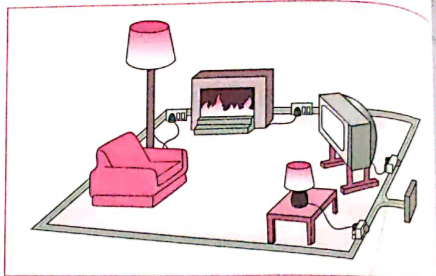Solve:
Two resistors having resistance of 16 and 14 are connected in series, if a potential difference of 18 V is applied across them, calculate the current flowing through the circuit and the potential difference across each individual resistorSolution in Marathi
R1=16ΩandR2=14Ω
Rs=14Ω+16Ω=30Ω
Let the current flowing through the circuit be I and the potential differences across the end 16Ωand14Ω be V1andV2 respectively.
V=IR V=V1V+V2=18V
I=VR =18V30Ω
∴I=0.6A
V1=IR1
V1=0.6×16=9.6V
V2=IR2=0.6×14=8.4V
∴ The current flowing in the circuit is 0.6 A and the potential differences across the end of the resistances 16Ωand14Ωare9.6Vand8.4V respectively.
Topper's Solved these Questions
- CURRENT ELECTRICITY Book:BAL BHARTIChapter:CURRENT ELECTRICITY Exercise:Can you recall?
Explore 1 Video
- CURRENT ELECTRICITY Book:BAL BHARTIChapter:CURRENT ELECTRICITY Exercise:Exercises
Explore 25 Videos
- INFORMATION COMMUNICATION TECHNOLOGY : THE NEW DIRECTION OF PROGRESSBook:BAL BHARTIChapter:INFORMATION COMMUNICATION TECHNOLOGY : THE NEW DIRECTION OF PROGRESSExercise:EXERCISE
Explore 3 Videos
Similar Questions
Answer the following question:
You must have seen a waterfull. Which way does the water flow?
View SolutionAnswer the following question:
The accompanying figure shows some electrical appliances connected in a circuit in a house.

By which method are the appliances connected?
View SolutionExplain the differences between the different generations of computers. How did science contribute to these developments?
View SolutionThe current following through a resistor connected in an electric circuit and the potential difference applied across its ends are shown in the figures below : The value of the resistance of the resistor is :
View SolutionA resister of 80 Omega is connected to a cell and the potential difference across the resistor is 40 V. Then the amount of current that flows through the given resistor is "_____" A.
View SolutionHow much current is flowing through a 1kΩ resistor when a potential difference of 2 V is applied across its end ?
View SolutionA batery, with potential V across it, is connected to a combination of two idential resistors and them has current I through it. What are the potential difference acros and the current through either resistor if the resistors are (a) in series and (b) in parallel?
View SolutionExperimentally prove that in series combination of three resistances: (a) Current flowing through each resistance is same , and (b) total potential difference is equal to the sum of potential differences across individual resistors.
View SolutionIf Three resistors of 6Ω,9Ωand21Ω are connected in series to a 12 V battery, find
a] The total resistance of the circuit.
b] The current flowing through the circuit.
c] The potential difference across the 21Ω resistor.
View SolutionSolve: Two resistors having resistance of 16 and 14 are connected in series, if a potential difference of 18 V is applied across them, calculate the current flowing through the circuit and the potential difference across each individual resistor
View SolutionA resistor of 6 Omega is connected in series with another resistor of 4 Omega . A potential difference of 20 V is applied across the combination. Calculate : the current in the circuit,
View SolutionA resistor of 6 Ω is connected in series with another resistor of 4 Ω. A potential difference of 20 V is applied across the combination. Calculate :
the potential difference across the 6 Ω resistor.
View SolutionIf Three resistors of 6Ω,9Ωand21Ω are connected in series to a 12 V battery, find
a] The total resistance of the circuit.
b] The current flowing through the circuit.
c] The potential difference across the 21Ω resistor.
View Solutionजब प्रतिरोधक को श्रेणीक्रम में संयोजित किया जाता है तब विभिन्न प्रतिरोधक में बहने वाला धारा होगा-
View Solutionकिसी परिपथ में श्रेणी क्रम में लगे कई प्रतिरोधों से बहने वाली धारा एवं उनके सिरों पर विभवान्तर मापने के लिए प्रयुक्त करेंगे
View Solutionश्रेणीक्रम में संयोजित प्रतिरोधों का विभवान्तर, ........ होगा।
View Solution